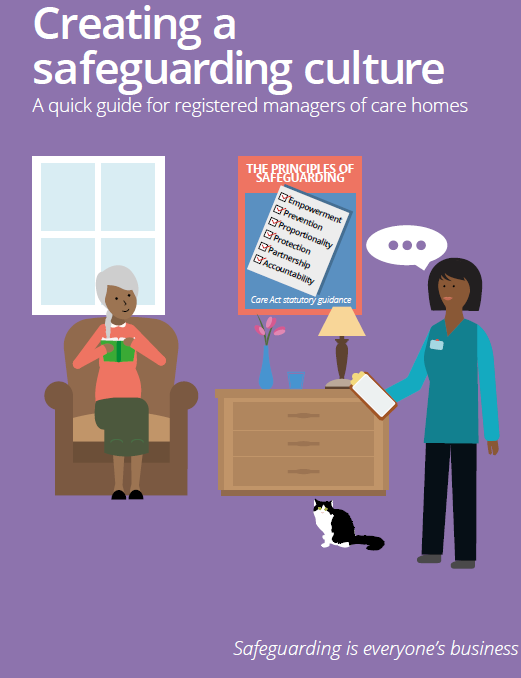A quick guide for registered managers of care homes
Safeguarding adults in care homes means protecting their right to live in safety and acting to prevent abuse and neglect. Working together to achieve this is everyone’s responsibility.
The Care Act 2014 and its statutory guidance outline what safeguarding arrangements all organisations should have in place, including a policy and procedure that reflect the local safeguarding arrangements.
Safeguarding in care homes should also be informed by the Making Safeguarding Personal framework.
Safeguarding policy
This should:
- Be clearly written (taking the Accessible Information Standard into account) and located so that everyone (staff, residents, visitors) can easily read it.
- Be absolutely clear about how to identify, respond to and manage safeguarding concerns and involve residents and their families and carers in designing and reviewing these arrangements.
- Explain how to report suspected abuse or neglect.
- Reflect the principle of working together.
Systems and procedures
Systems and procedures should also be in place to:
- Preserve evidence from reported concerns, including care records.
- Record and share information (in line with data protection laws) about any concerns.
- Track and monitor incidents, accidents, disciplinary action (including allegations made against staff), complaints and safeguarding concerns to help identify any patterns, themes or trends.
Whistleblowing
Whistleblowing is raising a concern about something happening in the care home which could harm those who live or work there. A good whistleblowing policy helps staff feel able to report safeguarding concerns internally, as a first step, but also understand how to do so through other routes if they either feel unable to do this or if they receive an unsatisfactory response.
Make sure a whistleblowing policy and procedure are in place and that staff and volunteers are aware of them. The procedure should clearly explain how to report a concern, who to contact and how to do so. Consider using an external whistleblowing service and, if used, check that staff know how to contact it.
Remember that:
- Whistleblowers are protected by law and must not be victimised.
- Staff and volunteers may be afraid of what might happen if they whistleblow. This can stop them from identifying and reporting abuse and neglect.
Roles and responsibilities
Care homes are required to have a safeguarding lead who may be the registered manager. It is important that everyone in the care home understands who is accountable for the different parts of safeguarding.
- Does everyone know who the safeguarding lead is, what they do, how to contact them and who to speak to if they are unavailable?
- Are safeguarding responsibilities included in all job descriptions?
- Does everyone understand how to meet their safeguarding responsibilities in their day-to-day work?
A positive culture
Care homes that encourage open conversations about safeguarding, and where suspected or alleged abuse and neglect can be readily reported, will be well placed to prevent incidents and respond effectively.
- Make support available for anyone raising concerns. This could include having safeguarding champions.
- Encourage staff to look out for changes in residents’ mood or behaviour, as this could indicate abuse or neglect. Any changes or other concerns should be recorded and shared as soon as possible and immediate action taken if abuse or neglect is considered or suspected.
- Ask residents and their families about their experience of raising safeguarding concerns – how do they feel about how their concerns were identified, reported, managed and resolved?
- Make any changes needed in response to this feedback and let people know what action has been taken.
Use team meetings and supervision to enable all staff, including those who work alone or at night, to:
- Share best practicae in safeguarding and learn from any relevant Safeguarding Adults Reviews, which should be available from your local Safeguarding Adults Board.
- Challenge poor practice or discuss uncertainty around practice.
- Talk about the differences between poor practice (which may not be a safeguarding issue) and abuse or neglect.

Management and supervision
Managers and supervisors have an important role to play in encouraging and supporting care staff to challenge poor practice and raise concerns about potential abuse or neglect.
Use reflective supervision to help staff understand how to identify and respond to abuse and neglect.
Use exit interviews with staff leaving the care home to explore how they felt about the culture, learning and management around safeguarding.
Positively acknowledge in supervision and appraisals how staff have learned from their experience of identifying, reporting and managing safeguarding concerns.
Be aware that staff who are afraid of losing their job may under-report safeguarding concerns.
Reflective supervision
Reflective supervision can help staff develop self-awareness, critical thinking and sound decision-making. It involves:
- Thinking through previous practice and exploring what happened, what you did, and why you made particular decisions, and acted or behaved in particular ways.
- Discussing how you feel about your own actions and those of others.
- Continually learning by identifying what you did well, what you could have done better and what you will do next time.
Useful links
- Safeguarding adults in care homes – NICE guideline covering various aspects including immediate actions if abuse or neglect is considered or suspected, supporting staff and residents, and learning from concerns and enquiries. Supporting documents also include indicators of individual abuse and neglect (PDF) and indicators of organisational abuse and neglect (PDF).
- Decision-making and mental capacity – NICE guideline and quality standard
- Making Safeguarding Personal: what might ‘good’ look like for health and social care commissioners and providers? – Local Government Association with ADASS
- Whistleblowing: Quick guide to raising a concern with CQC – Care Quality Commission (CQC).
- Whistleblowing: Guidance for providers who are registered with the Care Quality Commission (PDF) – Care Quality Commission (CQC).
- Care and support statutory guidance – Department of Health and Social Care.
- Safeguarding adults – Social Care Institute for Excellence.

Download this guide
We've created a copy of this guide that you can print and share:
This content has been co-produced by NICE and the social care institute for excellence (SCIE). It is based on NICE’s guideline on safeguarding adults in care homes.